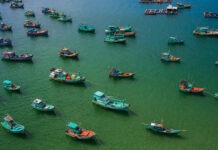A trip to Peru takes you back in time and allows you to rediscover the exciting lives of the Incas, Chancas, Chachapoyas, Mochicas, and Wari, as well as their great works of art, their feasts, the roots of their social strength and the energy of their people. Discover a wealth of different worlds, giant sand dunes, chiseled peaks and Pacific breaks, this vast country translates to paradise for the active traveler.
Spot scarlet macaws in the Amazon or catch the sunset over the dusty remnants of an ancient civilization. It is a place of mythical beliefs where ancient pageants unwind to the tune of booming brass bands. Peru’s rich cultural heritage is never more real and visceral than when you are immersed street side in the swirling madness of a festival. Here are the top destinations.

Lima: Museums with great works of art, archaeological sites, beaches, the boardwalk, valleys, natural reserves, the nightlife, the thrill of adventure sports, and the exquisite cuisine gives Peru’s capital an authentic personality and makes tourism in Lima a unique experience in the country.
Lima’s history predates the colonial presence in the country. The establishment of the viceroyalty transformed the city into the main political and administrative center of South America. During this period, significant churches, monasteries, mansions and balconies were built, which is why it is recognized as a World Heritage Site.

Amazonas: The Amazonas region is famous for its cloud forests, páramo (alpine tundra ecosystem) and exceptional microclimates. It is home to orchids, Andean bears and cocks-of-the-rock, as well as archaeological sites like the enigma of Kuélap, the citadel built between the Andes and the jungle, and mysterious tombs and sarcophagi, the legacy of the Chachapoya culture that once reigned here.
Mansions and colonial balconies and a landscape of lakes and gigantic waterfalls like Gocta and Yumbilla create a destination with endless possibilities.

Madre de Dios: Madre de Dios is home to never-ending forests, winding rivers and abundant wildlife. It is a wildlife reserve and refuge for endangered species, like the maned wolf and marsh deer. This region is also home to indigenous communities that promote ecotourism in regions with some of the richest biodiversity in the world, such as Lake Sandoval, Lake Valencia, Manu National Park, Tambopata National Reserve and Bahuaja-Sonene National Park, the only tropical, humid savannah ecosystem in Peru.

Lambayeque: Here, in the desert and the sweltering valleys, lie important archaeological remains, such as pyramids and administrative centers. This is the land of the kings that ruled the north of Peru centuries ago, one of whom has returned from the past: the Lord of Sipán. There are also other significant archaeological sites to explore, such as Sicán, Túcume and Chotuna, as well as state-of-the-art museums with priceless collections.
Lambayeque also has beaches, like the balneario de Pimentel, nature, in the form of the Pómac forest and the Chaparrí reserve, and an excellent gastronomic tradition that reflect the culture of its people.

La Libertad: Temples, pyramids and cities of mud that survive inclement weather: Chan Chan, Huaca del Sol y la Luna, el Brujo are some of the most remarkable destinations in the province of La Libertad. It offers exquisite colonial architecture in the beautiful mansions that line its streets, living culture with deeply-rooted customs like fishing on Caballitos de Tortora (the traditional reed rafts of the northern coast), and renowned beaches that attract surfers from around the world.
It is the birthplace of the seductive ‘marinera’, the national dance of Peru. La Libertad, the very picture of ancient nobility.

Huánuco: Huánuco was a colonial center where temples, haciendas and mansions were built in an area that, for centuries, had been populated by the Lauricocha and other cultures, who left traces of their presence in the Kotosh ‘Templo de la Manos Cruzadas ‘ (Temple of the Crossed Hands). This beautiful area has forests full of sought-after fruits like coffee and cocoa, along with a variety of protected flora and fauna in the Tino María national park. High mountains, hot springs, caves, lagoons, and a remarkable rock formation called Sleeping Beauty, make Huánuco the soul of the Andes, dressed in jungle.

Junín: Highlands and jungle. Waterfalls and fertile valleys. Pristine landscapes. Handicrafts and folklore. Junín is charming like love at first sight. Villages with deep religious traditions, such as Tarma. A National Reserve with birds and mammals of the Andes. A handicraft route where you can see the production of fine weaving and metalwork in gold and silver.
And as a backdrop, a dark green carpet of forests in Satipo and Chanchamayo, with botanical gardens and accommodation in native communities.

















